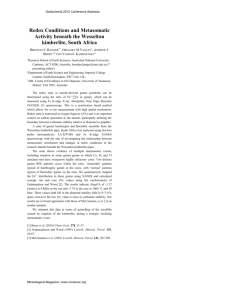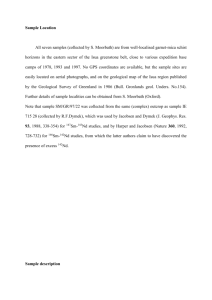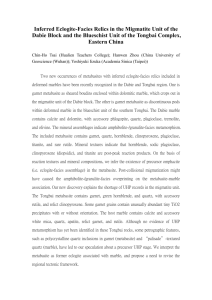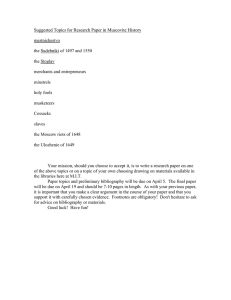values listed by Slemmons (Table 3, t962a).It seems most probable
advertisement
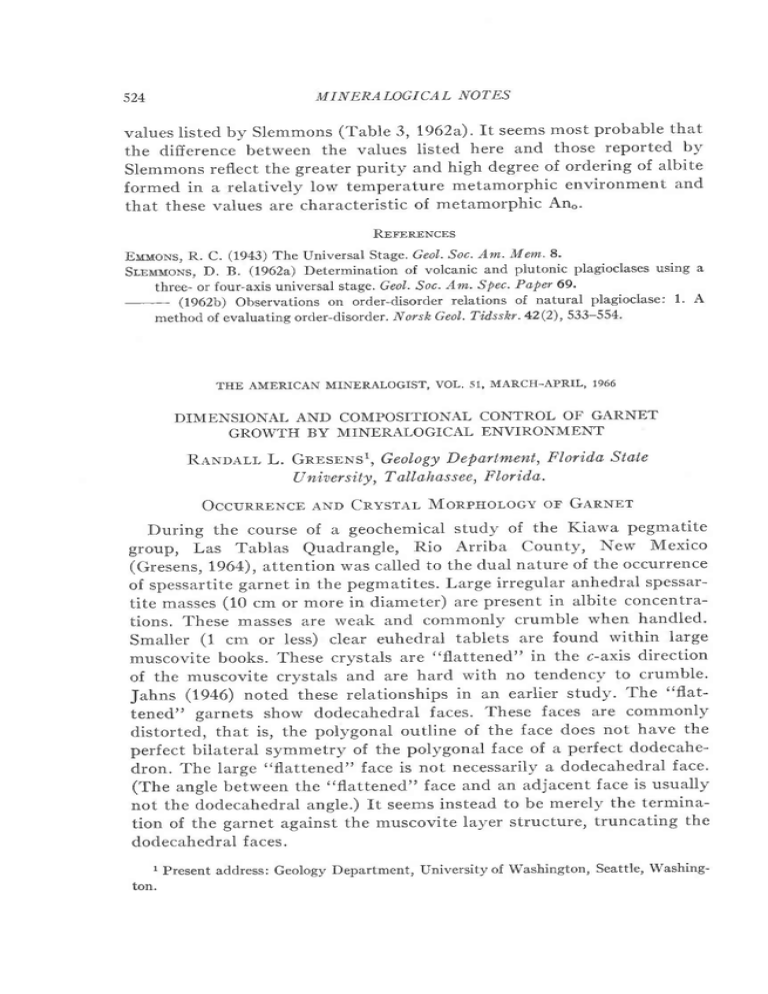
MINERALOGICAL 524 NOTES valueslisted by Slemmons(Table 3, t962a).It seemsmost probable that the difference between the values listed here and those reported by Slemmonsreflect the greater purity and high degreeof ordering of albite formed in a relatively low temperature metamorphic environment and that these values are characteristicof metamorphic Ano. RrrnnrNcrs EMMoNS,R. C. (1943) The Universal Stage' Geotr'Soc. Am. Mem' 8' srrv.moNs, D. B. (1962a) Determination of volcanic and plutonic plagioclases using a three- or four-axis universal stage. Geol. Soc. Am. Spec. Paper 69' (1g62il Observations on order-disorder rejations of natural plagioclase: 1 A method of evaluating order-disorder' N orsh Geotr.TiiJsskr. 42 (2), 533-554' THE AMERICAN MINERALOGIST, VOL. 51, MARCH-APRIL' 1966 DIMENSIONAL AND COMPOSITIONALCONTROLOF GARNET GROWTHBY MINERALOGICAL ENVIRONMENT ReNn'lrr- L. Gnrscwsr, GeologyDepartment,Flori,da State fl niaersity, T allahassee,F lorida. OccunnpNcB AND CRYSTAL MoRPHoLoGY oF GARNET During the course of a geochemicalstudy of the Kiawa pegmatite group, Las Tablas Quadrangle, Rio Arriba County, New Mexico (Gresens,1964),attention was calledto the dual nature of the occurrence of spessartitegarnet in the pegmatites.Large irregular anhedralspessartite masses(10 cm or more in diameter) are present in albite concentrations. These massesare weak and commonly crumble when handled. Smaller (1 cm or less) clear euhedral tablets are found within large muscovite books. These crystals are "flattened" in the c-axis direction of the muscovite crystals and are hard with no tendency to crumble' Jahns (19,16)noted these relationships in an earlier study. The "flattened" garnets show dodecahedralfaces. These faces are commonly distorted, that is, the polygonal outline of the face does not have the perfect bilateral symmetry of the polygonal face of a perfect dodecahedron. The large "flattened" face is not necessarilya dodecahedralface' (The angle between the "flattened" face and an adjacent face is usually not the dodecahedralangle') rt seemsinstead to be merell' the termination of the garnet against the muscovite layer structure, truncating the dodecahedralfaces. l Present address: Geology Department, Universityof Washington, Seattle, Washing- MINERALOGICAL NOTES MrNBnarocrcer EuvrnoNMENTas a CoNrnor oN Cnvsrel Monpnorocy The occurrenceof the "flattened" crystals in particurar argues against growth of the surrounding mineral around pre-existing garnet. rf the garnet had been formed prior to the muscovite, the enclosed garnet. should be more equidimensional. Also, the "flattened" garnets are found only in muscovite books. The control exerted by the muscovite crystal lattice on the dimensional growth of the garnet impries that the two mineralseither grew simultaneouslyor that the "flattened" garnetsgrew within pre-existing muscovite crystals. The age relationshipbetweenalbite and the rargegarnet massesis not as clear. As pointed out by Jahns (1946),the albite is a late replacement feature in the pegmatite. The garnet courd have been formed either before or after the albite. rrowever, even if the albite is later than the garnet' the garnet would probably have been originally surrounded by perthite or quartz rather than muscovite before the replacement of these neously with or later than the albite. For example, Jahns (1946), con_ sidered that the associationof most of the mica with albite indicated The exact age relationship is not necessaryfor the discussionthat follows. What is important is that the medium (albite, perthite, quartz, or fluid) surrounding the large garnet massesduring growth was different from the medium (muscovite)surroundingthe "flattened" garnetsduring their growth. Devore (1959)discussedminimum interfacial free energy as a control on certain features of mineral assemblages,including grain form. The "flattened" garnets may be an example of this kind of control. The "flattened" form presentsa large garnet surface area to the (001) face of the surrounding muscovite and a minimum interfacial garnet surface to other planes in the muscovite crystal. This suggeststhat the interface betweengarnet and the (001) plane in muscoviteis the interfaceof lowest free energy. MINDRALOGICAL NOTES 526 CnnMrc,q.LColrposrrroN ol G'q'nxBr Spectrochemicalanalysesb,v the author of the two types of garnet are presentedin Table 1. Sodium and potassium were not determined, and -ungut.r. fell above the upper limit of the working curve' Both of the analysed garnets came from the South Kiawa deposit, and they were located about 8 meters apart. The analyses show compositional differences between the two modes of occurrence.The most pronounced t-- I. S-""t"""""* Element SiOzTo Tio, Alzo: Fe MnO Mgo CaO ZrOz PPM CrzO: SczO: VzOs YgOr BeO SrO BaO CuO Nio Euhedral "Flattened" Garnet 43 <0.1 22 /J High 0.40 1.1 49 25 7 92 1200 140 13 not detect. 9 330 Anhedral Massive Garnet 43 o.25 22 3.9 High <0.1 0.7 o/ JI 10 87 530 o 27 IJ 8 460 differencesare the higher iron, beryllium, yttrium and magnesium content of the "flattened" garnet and the higher titanium and nickel content of the anhedral massive garnet. Although this comparisonis based on only two analyses and additional work should be performed, certain tentative conclusionscan be drawn. AS A CoNTROLoN MrwpnalocrcAr- ENVTRoNMENT CouposrrroN CnBlrrcer rn addition to the dimensional control exerted by the mineralogical environment, a compositionalcontrol may also have been present. Suppose that the garnets represent growth simultaneouswith that of the enclosing minerals. Becausegrowth takes place by additions to the surface, the surfaceenergy differencebetween the feldspar (?)-garnetinter- MINER- LOGI1!,L NOTES 527 face and the muscovite-garnet interfac! could lead to compositional differencesbetween the garnetsof the two environments.Additions to the mineral are controlledin part by the state of the mineral surface.When two mineral surfaces are in contact, there are mutual interactions between their force fields. Mutual polarization of the surface atoms can occur. The surface of a garnet in contact with muscovite is thus energetically different from the surface of the same garnet in contact with feldspar, qrrartz, or even a fluid. The differences,however small, could Iead to discrimination with respect to certain atoms during crystal growth. If the "flattened" garnets grew by replacementwithin a pre-existing muscovite crystal, the above argument still holds, but an additional factor may be considered.At least some of the elements composing the garnet must then have reached the site of growth by intracrystalline diffusion through the muscovite. The muscovite could have a "sieve" effect with respect to ionic diffusion, allowing some elements to difiuse more freely than others. This could also result in compositional differe n c e s .S i m i l a r l y ,i f t h e l a r g e g a r n e t sa r e l a t e r t h a n t h e f e l d s p a r( m i c r o cline or albite) or quartz, growth must have taken place by difiusion along feldsparfqtartz grain boundaries or through feldspar/quartz crystals. A "sieve" effect could also be present in this situation. Compositional differencescould also result from incorporation of some of the components of the host mineral in the guest mineral during replacement. This would also be a compositional control because of mineralogical environment. The postulated reasonsfor the compositional differencesbetween the two garnets have been of a very general nature and somewhat speculative. An attempt to be more specific would be even more speculative. For example, the higher iron content of the "flattened" garnet could be attributed to at least three mechanisms: (1) Iron was available in about equal amounts at both sites, but the sutface conditions controlling the crystal growth resulted in a higher iron content in the "flattened" garnets. (2) The muscovite crystal lattice exerted a "sieve" effect, allowing iron to difiuse more freely than manganese (Fe2+ has a smaller ionic radius than Mn2.+). (3) The higher iron content of the "flattened" garnet is simply due to the higher iron content of the muscovite (usually about 4.50/6 Fe) as opposed to that of feldspar (only a trace). The excess iron is therefore iron incorporated by the garnet from the host muscovite during replacement. Another example is the higher yttrium and beryllium content of the "flattened" garnet. It might be argued that this means that yttrium and beryllium could diffuse freely through the muscovite crystal lattice. This is highly speculative to begin with, but is even further complicated by the fact that there is little similarity between yttrium and beryllium 528 MINERALOGICALNOTES with respect to ionic size, charge, polarizing power, etc. Therefore, to assignspec'if,cdifferencesin composition to a single mechanism is difficult. In the more generaisense,either of the three mechanismsdiscussed above in relation to iron content are ultimately due to differencesin the mineralogicalenvironmentsof the two garnets. Another possibility is that the "flattened" garnets formed b1' exsolution within the muscovite. However, as pointed out by DeVore (1964, pers.comm.),if the garnet grew by exsolution,almost all of the muscovite crystals should have a few. In the Kiawa depositsmost mica books do not contain garnet inclusions. It is also possiblethat the two occurrencesof garnet were formed at different times from different chemical environments. Although the two analysedgarnets were only 8 meters apart in the same pegmatite body, this remains a very real possibility. It doesnot, however,invalidate the possibility that the mineralogicalenvironment also exerted a control on the cr)rstal composition. The fact that one of the garnets is in a distinctly special mineralogical environment (a muscovite book) and that the environment exerted a definite dimensional control during crystal growth lends support to the possibility that the mineralogical environment also exerted a compositionalcontrol during crystal growth. The author is grateful to Dr. G. W. DeVore for his critical appraisal of the manuscript. Rnrcr-oNcBs DrVonr, G. W. (1959) Role of minimum interfacial free energy in determining the macroscopic features of mineral assemblages.L The model. J our. Geol.67, 211-227. Gnesnxs, R. L. (1964) A geochemical and structural study of metasomatic formation of certain pegmatites. Unpubl. Ph.D. thesis, Florida State University. Jarrws, R. H. (1946) Mica deposits of the Petaca District, Rio Arriba County, New Mexico. N. Mer. Bur Mines Mi.neral Res. Bull.25.

